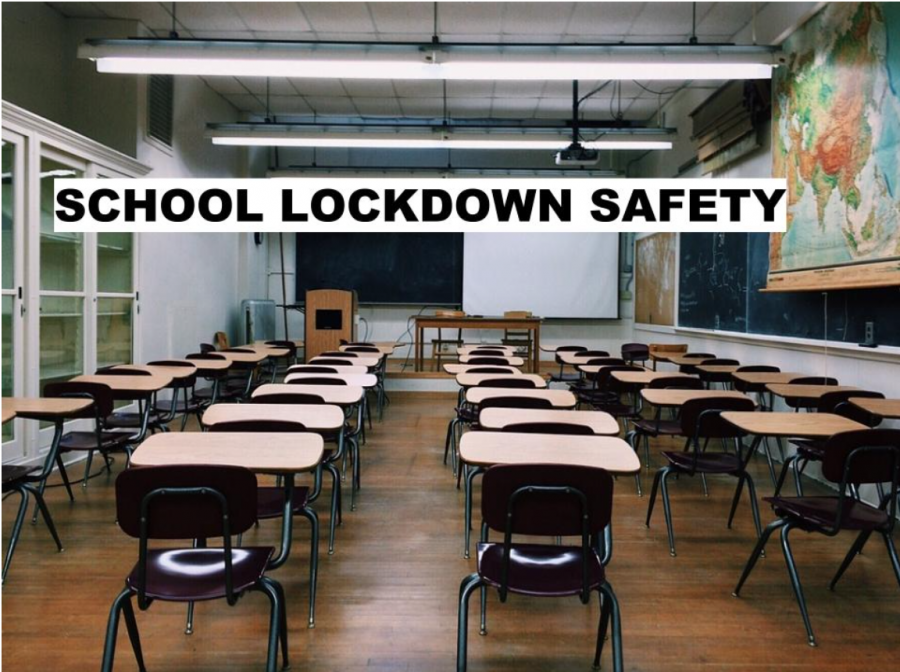Safety protocols in the school halls
Do the drills we practice really keep us safe or do we need to seek other options?
May 11, 2023
Do you think that the survival measures we’ve coordinated in the event of a school shooting would actually be effective if one were to happen? To phrase this question simply: Do you think the protocols we practice in lockdown drills would actually keep us safe if someone decided to try to kill us? This is a question that I’ve asked myself since I was old enough to realize that being in school in America can be dangerous. Of course, back then, all the teachers told us that events like that doesn’t happen here. Then last year happened and the safety I found in the school walls shattered completely.
Last year, there were multiple threats made to the school. Three of them resulted in lockouts and one caused a full blown lockdown. Thankfully, nothing happened, but it was enough to give me nightmares for a little while afterwards. These events took up most of the discussions I had with my therapist.
Why do you feel like our procedures, our preparation, our desperation to survive might not overcome someone else’s hate? It’s obvious that I ended up okay in the end after my lockdown experience (physically anyway), but in truth, there was actually no real danger to be had on that day. If the danger had been real, and someone had been out for blood in these hallways that day, would I still be okay? Would I be typing this today because of our lifesaving safety procedures, out of sheer luck, or not at all? Let’s consider what the facts say.
Most of what we do to prepare for school shootings is based on the belief that the person trying to kill us doesn’t know where they’re going or what they’re doing. According to the Government Accountability Office, however, half of school shootings are committed by current or former students. There’s nearly a 50% chance that someone trying to take our lives will know the layout of the school, will know where we hide, and will know where to hide. What are you supposed to do in a scenario like that? Do you just sit there, knowing that this person could know exactly where you are? Run away and risk your life trying to escape? Could you actually even do it, or would you be too petrified to move? Hopefully, you’ll never have to learn. If you do however, will the school and all the drills you’ve spent years learning save you?
Thankfully, there’s still the remaining half of potential shooters who won’t know our procedure specifically, but what if they don’t even need that knowledge? It’s no secret that our classroom doors are made of wood. The locks on our doors aren’t indestructible either, and even if they were, I doubt that the chicken wire in our windows will hold back bullets and keep us 100% safe. “But we barricade the doors! Surely that will keep us safe?” Will it really? The desks that we’re expected to use as barricades are plastic, lightweight, and easy to move. As if that isn’t tragic enough, the objects that could actually be useful as a barricade might take too long to get into place. A lot can happen in the seconds you spend dragging something in front of the door. Those seconds could be life saving or life ending.
What can we do instead of explaining our plans to a potential shooter? There are many propositions, such as not performing drills with students present and having them rely solely on the teacher’s instructions during a shooting. This wouldn’t give any student shooters as many clues, but also would render other students unprepared. Many people suggest arming teachers, though if a destructive student were to find a gun in the classroom, that might just make things worse. As time goes on, the solutions only seem to get more and more controversial. Until the best solution arises though, many schools across the country are preparing for shootings in various ways.
On February 2nd of this year, TikTok user @larrylexicon, a well known teacher that regularly makes comedy videos with his class, took a moment to be serious. He posted a TikTok about a bucket he had in the classroom. This bucket was full of survival items to use in case of a school lockdown. This included the following objects: toilet paper, a privacy tent, aluminum blankets, and more. According to him, each classroom at his school has one. The bucket itself is meant to be used as a makeshift toilet for however long a lockdown may last. The tent is meant to give students some privacy, and the blankets are used to cover bodies. Other classrooms, such as those inside West Elementary School in Cullman, Alabama, are trying out a new, innovative method to shield students from flying bullets by installing a “Rapid Access Safe Room.” NowThis News describes the Rapid Access Safe Rooms as small, bulletproof, folding rooms that students can hide in. I’ll be honest, I tried to be happy about this, but I just ended up getting sad. It’s incredibly disheartening that we even have to resort to measures like these. Not only that, but most schools won’t have things like these. For many students, there will be no comfort behind their walls–no privacy, nothing. Many students may have to experience humiliation, trauma, or worse, death.
So, half of school shooters know what’s going on behind closed doors when they’re in the halls and our safety procedure may not be enough to stop them. Is there anything we can do beforehand to prevent these shootings from happening in the first place? The Sandy Hook Promise states that in four out of five school shooting cases, someone aside from the shooter knows in advance and chooses not to report it. Not only that, but nearly all school shooters share threatening or concerning messages or images beforehand. Brookings.edu explains how student shooters often feel very alone in school and how many exhibit signs of depression and suicidal ideation, another reason why mental health at school should be a priority.
If we know what to look for, know what to do, and know who to turn to, we can prevent school shootings. It’s beyond nerve-wracking to bring something of that magnitude to light, but it has to be done for the safety of you and your peers. For now however, while we are still safe, we need to ask ourselves: is there anything we could do better? Are there better ways to prepare and protect ourselves in a situation like that? As a student, the decision isn’t mine to make. It’s the school administration’s, so what do the admins have to say about all of this?
In an interview with Assistant Principal Bush, I asked him an array of questions surrounding the topic of our lockdown protocols and their effectiveness. When asked if he thought there was anything to be improved upon with our school lockdown protocols, he described how the school administration is always seeking improvement. “We are constantly reviewing and analyzing [lockdown protocols], and anytime there are situations that might occur around the country, we take a deep dive into what might have gone wrong in some of those situations and how we can use that information to be as prepared for the hopefully unthinkable.” Bush states.
Mr. Bush also detailed some of the new safety features incorporated into the layout of the new building here S.H.S.. Angled doorways, specially marked carpets to make hiding easier, and more have been literally built into the school addition. “These types of things are thought of well in advance by architects and people around the country who definitely want to continue to have the safest, securest schools that we can be in.” Bush says.
The final question of my interview with Mr. Bush was what he’d personally like to change about how we handle our lockdown procedures. His statement made it clear that he’s a man who cares for others and wants what’s best for the school both physically and emotionally. “The number one thing that I wish that I could change is the feeling that people get when preparing for these types of situations. I would love to take away that feeling of anxiousness.” I like to believe that this is a sentiment held by all school administrators.
Life as a student is already difficult, but having to worry about how safe you’d be if someone came in with the intention to hurt you just adds fuel to the fire. Is what we have enough, or does more need to be done? Many students across America have found their personal answer after such an event. Hopefully, you never will.




